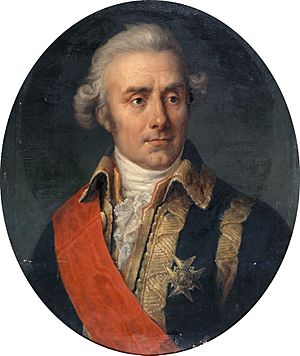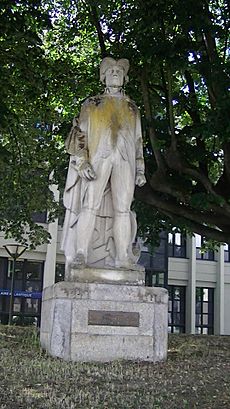Louis Charles du Chaffault de Besné facts for kids
Louis Charles du Chaffault de Besné was a brave French Navy officer. He was born in Montaigu on February 29, 1708, and passed away in Nantes on June 29, 1794. He is remembered for his important roles in major sea battles, including the Second Battle of Cape Finisterre in 1747 and the Battle of Ushant in 1778.
Quick facts for kids
Louis Charles du Chaffault de Besné
|
|
|---|---|

Posthumous 1839 painting of Du Chaffault.
|
|
| Born | 29 February 1708 Montaigu |
| Died | 29 June 1794 |
| Occupation | Officer of the French Navy |
| Rank | Gardes de la Marine (1725–), ensign (1733–), lieutenant de vaisseau (1746–), capitaine de vaisseau (1754–), Chef d'escadre (1764–), lieutenant général des Armées navales (1777–), vice admiral (1792–) |
Contents
Louis Charles du Chaffault de Besné began his career in the French Navy in November 1725. He joined as a Garde-Marine, which was a bit like a naval cadet. In 1727, he served on a large 70-gun ship called the Achille near Spain.
The next year, he took part in the Bombardment of Tripoli. He was on the 30-gun frigate Astrée during this mission.
Rising Through the Ranks
Duchaffault was promoted to Ensign in 1733. He worked in Brest for a while before returning to the frigate Astrée in 1737. On this ship, he helped fight against the Salé Rovers, who were pirates.
In 1739, he served on the 16-gun Méduse in the Baltic Sea. The following year, he was in the Caribbean on the 46-gun ship Parfaite. From 1742 to 1744, he served on the 64-gun ship Saint Michel.
Command and Battles
He became a Lieutenant in 1746. In February 1747, he was given command of the 40-gun frigate Atalante. He sailed with another frigate, Sirène, off Saint-Domingue.
Later that year, on October 25, 1747, he showed great skill at the Second Battle of Cape Finisterre. In 1751, he captained the 24-gun frigate Friponne for missions near Saint-Domingue.
Captain and Squadron Leader
Duchaffault was promoted to Captain in 1754. He commanded the 80-gun ship Formidable. He later returned to the Atalante, which was part of a squadron. On March 11, 1756, he helped capture the British ship HMS Warwick.
He also took part in the Siege of Louisbourg in 1758, commanding the ship Dragon. That same year, he led a group of ships and captured an East Indiaman merchant ship called Carnarvon. In 1760, he captained the 70-gun ship Magnifique.
Admiral Ranks and Final Years
Duchaffault was promoted to Chef d'escadre in 1764. In June 1765, he participated in the Larache expedition. In 1772, he helped create the Escadre d'évolution, a special training squadron, commanding the 50-gun ship Fier.
He became a Lieutenant général des Armées navales on February 6, 1777. He commanded the rear part of the French fleet at the Battle of Ushant on July 27, 1778. His flag was on the 80-gun ship Couronne, and he was seriously injured during this battle.
In 1779, he led a division in the Armada of 1779, with his flag on the ship Ville de Paris. He then became the commander of naval forces in Rochefort. He was promoted to Vice-amiral on January 1, 1792.
During a difficult time in French history, Duchaffault was arrested. He passed away while in custody in Nantes on June 29, 1794.
Legacy
Duchaffault's life and achievements have been remembered. In 1931, a naval historian named André Vovard wrote a book about him called L'Amiral du Chaffault. That same year, Paul Chack also published a book titled L'homme d'Ouessant, Du Chaffault.
Today, streets in Paris and Nantes are named in his honor. These include Rue du Chaffault in Paris and Rue Amiral-du-Chaffault in Nantes.


